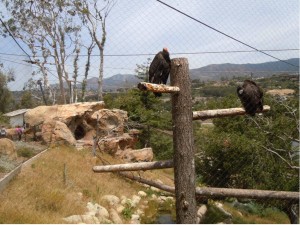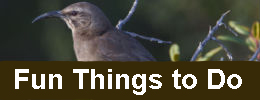Zoos nationally understand that conservation means protecting not only animals, but their habitat too, and many of them are doing just that. In fact, the Accreditation Standards of the American Association of Zoos and Aquariums (AZA) require that member organizations participate in conservation programs emphasizing “ecosystem conservation.”
Last June, Oakland elected officials gave approval to the Oakland Zoo to build a 56 acre California conservation theme park in one of the most remarkable natural ecosystems remaining in Oakland today, the Knowland Park highlands. Since the Santa Barbara Zoo had already opened a “California Trails” exhibit complex in 2009, I drove down last summer to see how they built the new exhibit while still keeping true to the conservation message.

Young condors at Santa Barbara’s “California Trails” exhibit complex participate in the California Condor Recovery Program – photo by Jim Hanson
It turns out that expansion at the Santa Barbara Zoo is also constrained by a freeway (Highway 101) and housing on one side and the City-owned Andree Clark Bird Refuge and Park on the other. However, rather than expand the new “California Trails” project into the park and refuge, the Santa Barbara Zoo – already just a third the size of Oakland Zoo – developed the exhibit within its existing fence line.
The Zoo’s exhibit focuses on California native species that are threatened and endangered today in Southern and Central California. These include the endangered California condors, Channel Island foxes, desert tortoises, and local reptiles and amphibians. The Zoo’s work on public awareness and their collaboration in public agency recovery efforts is helping to increase the numbers of these endangered species.
Oakland’s proposed project would exhibit animals that are already long extinct from the Bay Area, such as the Grizzly Bear. These large animals take more land to exhibit; therefore the Oakland Zoo has proposed to take over many acres of native habitat in Knowland Park that is already home to diverse native plant, animal, and bird life.
The Santa Barbara Zoo’s focus on today’s regionally threatened species seems to have the side benefit of allowing development within their existing fence line. Rather than develop in the adjacent park and refuge, the Zoo gets children and families out into the park to help care for the diverse California animal, bird, and other life that depend on Andree Clark park today.
Jim Hanson grew up in the East Bay and originally heard about out the City’s development plans for Knowland Park from the East Bay Chapter of the Native Plant Society and the Sierra Club Yodeler. A landscape architect, Jim appreciates the subtle beauty of the native bunchgrass prairies and meadow lands of California. He has served on the Board of Directors of the California Native Grasslands Association for several years and was recently elected its President. He likes to take fellow Oaklanders and Bay Area visitors to the Knowland Park highlands to point with pride how a vibrant, busy city still keeps its natural wealth.
 Follow
Follow







